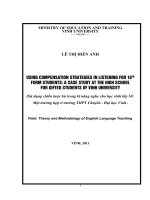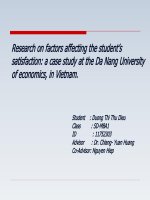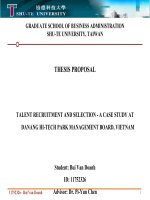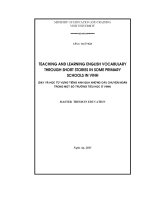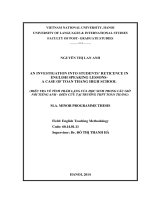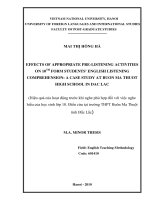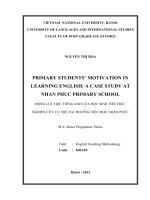Grade 10th students learning english vocabulary a case study at phalai high school
Bạn đang xem bản rút gọn của tài liệu. Xem và tải ngay bản đầy đủ của tài liệu tại đây (3.02 MB, 62 trang )
HANOI OPEN UNIVERSITY
FACULTY OF ENGLISH
CODE: 09
GRADUATION THESIS
B.A DEGREE IN ENGLISH STUDY
GRADE 10TH STUDENTS' LEARNING
ENGLISH VOCABULARY:
A CASE STUDY AT PHALAI HIGH SCHOOL
Supervisor
: Dr. Nguyen Van Quang
Name of student : Tran Van Thuat
Date of birth
: 25/07/1994
Class
: 1271A03 (2012- 2016)
Hanoi, 2016
DECLARATION
GRADE 10TH STUDENTS' LEARNINGENGLISH VOCABULARY:
A CASE STUDY AT PHALAI HIGH SCHOOL
(Graduation paper submitted in partial fulfill for B.A degree in English studies)
I certify that no part of the research has been copied or reproduced by me
from any other person’s work without acknowledgement and that the research
is originally written by me under strict guidance of my supervisor.
Hanoi, April, 2016
Student
Tran Van Thuat
Supervisor
Dr. Nguyen Van Quang
ACKNOWLEDGEMENT
I am, first of all, particularly indebted to my supervisor, Dr. Nguyen Van
Quang, for his invaluableadvice, instructions and correction, excellent
suggestions and constant encouragement during the research period. Without
his guidance and help, this work would not have been accomplished.
Secondly, my sincere thanks also go to all lecturers and staff of the Faculty of
English, Hanoi Open University for their valuable lessons and precious helps.
Thanks to their lessons as well as needed helps, I could overcome enormous
obstacles when doing the research.
Besides, I would like to give my heartfelt thanks to the teachers and grade
10th students at Pha Lai High School who have participated in this research
and many others who helped me during my study at Pha Lai High School.
Last but not least, I would like to convey my deepest gratitude to my family
members for their constant support and thorough understanding. Their great
encouragement and love have helped me to overcome the difficulties during
my study.
Hanoi, April, 2016
Student
Tran Van Thuat
Graduation Paper
TABLE OF CONTENTS
DECLARATION
ACKNOWLEDGEMENT
PART A: INTRODUCTION ................................................................................ 1
1. Rationale ............................................................................................................ 1
2. Aims of the study ............................................................................................... 3
3. Scope of the study .............................................................................................. 4
4. Research questions ............................................................................................ 4
5. Methods of the study ......................................................................................... 4
6. Design of the study............................................................................................. 4
PART B: DEVELOPMENT ................................................................................. 6
CHAPTER 1: THEORITICAL BACKGROUND ............................................... 6
1.1 Theory on vocabulary...................................................................................... 6
1.1.1 Definition of vocabulary ............................................................................. 6
1.1.2 The importance of vocabulary .................................................................... 7
1.1.3 Classification of vocabulary ....................................................................... 8
1.1.3.1 According to the concept of morpheme .................................................. 9
1.1.3.2 According to the meaning ..................................................................... 9
1.1.3.3 According to the function .................................................................... 10
1.1.3.4 According to the frequency of use ........................................................ 10
1.2 Vocabulary learning ...................................................................................... 12
1.2.1 Aspects need to be studied......................................................................... 12
1.2.2 English vocabularylearning strategies ..................................................... 13
1.2.2.1 Definition of English vocabulary learning strategies ........................... 13
1.2.2.2 Classification of English vocabulary learning strategies ..................... 13
CHAPTER 2: FINDINGS, INTERPRETATIONS & ANALYSES .................. 19
2.1 Methodology .................................................................................................. 19
2.1.1 Methods .................................................................................................... 19
Tran Van Thuat- 1271A03- (2012- 2016)
Graduation Paper
2.1.2 Subjects ..................................................................................................... 19
2.1.2.1 Grade 10th students at Phalai high school and their learning
background ..................................................................................................... 19
2.1.2.2 English teachers at Pha Lai High school ............................................. 20
2.1.2.3 Tieng Anh 10 coursebook and its vocabulary topics ............................ 20
2.1.3 Questionaires ............................................................................................ 23
2.1.3.1 Purposes ............................................................................................. 23
2.1.3.2 Discription of survey questionaires ..................................................... 23
2.1.4 Procudure ................................................................................................. 24
2.1.5 Data analysis ............................................................................................ 24
2.2 Findings and discussions ............................................................................... 34
CHAPTER 3: SUGGESTIONS TO IMPROVE ENGLISH VOCABULARY
LEARNINGFOR GRADE 10TH STUDENTS AT PHALAI HIGH SCHOOL . 36
3.1 Learning English vocabulary from pictures................................................. 36
3.2 Learning English vocabulary from funny games ......................................... 38
3.2.1 The jumble word game ............................................................................. 39
3.2.2 The “Crossword” game ............................................................................ 40
3.2.3 The word search game .............................................................................. 42
3.3 Leaning English vocabulary through mass media ....................................... 43
3.3.1 Using books, magazine, newspapers ......................................................... 43
3.3.2 Learning vocabulary by watching films or cartoons with English subtitles
........................................................................................................................... 46
3.3.3 Learning English vocabulary through Internet........................................... 56
PART C: CONCLUSION AND RECOMMENDATION ................................. 48
REFERENCES .................................................................................................... 49
APPENDICES
APPENDIX 1
APPENDIX 2
Tran Van Thuat- 1271A03- (2012- 2016)
Graduation Paper
LIST OF FIGURES ANDTABLES
LIST OF FIGURES
Figure 1: Students’ interests in learning English. .............................................. 24
Figure 2: The ways students often apply in memorizing words. .......................... 28
Figure 3: Students’ opinions toward current teaching method ............................ 32
Figure 4: Teachers’ opinions on using various techniques on teaching
vocabulary ............................................................................................................ 33
LIST OF TABLES
Table 1: Vocabulary topics presented in Tieng Anh 10 coursebook .................... 22
Table 2: Teachers’ and students’ opinions toward the role of English vocabulary.
.............................................................................................................................. 25
Table 3: Students’and teachers’ difficulties in learning and teaching vocabulary
.............................................................................................................................. 26
Table 4: Strategies employed by students in getting the meaning of the words .... 27
Table 5: Current teaching techniques and thier effectiveness.............................. 29
Table 6: The frequency of adopted techniques on teaching vocabulary ............ 300
Table 7: Students ’expectations to improve their vocabulary learning................. 33
Tran Van Thuat- 1271A03- (2012- 2016)
Graduation Paper
PART A: INTRODUCTION
1. Rationale
Each nation has their own language, custom and culture. To have a common
voice, all nations in the world need have a common language and English is
such a language.
In Vietnam, since the implementation of the open door policy, it is now a
great demand to learn English for the process of integrating into regional and
international economic and diplomatic development. Studying English,
students have chances to know many interesting things around the world.
However, it is not easy work because English is very variety and complex.
It has been, in fact, said that if language were a house, vocabulary would be a
construction material to build up that house. Therefore, studying a language
cannot be separated from studying vocabulary. Yet it is true that the
vocabulary is the focus of language. It is in words that sound and meaning
interlock to allow us to communicate with one another, and it is word that we
arrange together to make sentences, conversation, and discourse of all kinds.
However, it is not easy to study perfect English vocabulary. Almost students
often face up with some problems in learning vocabulary at first. In fact, it is
difficult to
memorize
a new word with its meaning, spelling and
pronunciation, many students are often confused with knowing how can apply
grammar into sentences, sometimes, they can not understand when being
opposed to video and audio.
For a long time, methodologists have continuously kept seeking effective
ways to teach and learn English vocabulary. Some books on learning English
vocabulary have been written by scholars such as Nation (1982, 1990 and
2000), Rubin and Thomson (1994) and Taylor (1990), etc.
Tran Van Thuat- 1271A03- (2012- 2016)
2
Graduation Paper
In Vietnam,several studies into this field have been conducted with different
type of learners to find out particular strategies employed by effective and
ineffective learners in learning English vocabulary such as Huyen Tran’s study
(2004) on vocabulary learning strategies used by students of English at Quy
Nhon University or Mai Van Binh's (2007) on vocabulary learning strategies
preferred by students at College of Finance and Business Administration.
However, research on effective ways to learn English vocabulary for 10th
form students at Phalai High School has not been done yet.
From the above reasons, the researcher has the ambition of presenting some
effective techniques to learn English vocabulary for students at PhaLai high
school, where the researcher studied in his school days and practiced teaching,
with hope that students will be interested in learning English. Due to his
English knowledge limitation and the frame of the graduation paper, the
researcher would like to choose the research paper entitle: “Grade 10th
students’ learning English vocabulary: a case study at Pha Lai High school”
2. Aims of the study
With the hope of helping grade 10th students at Pha Lai high school make
progress in studying vocabulary, this graduation paper is about to help the
students improve their own vocabulary and to prepare for them to the basic
knowledge of vocabulary with higher requirement for the next grades.
Specifically, the research aims at:
- Covering background knowledge of vocabulary
- Finding out reality of teaching and learning English at school.
- Investigating difficulties experienced by students of grade 10th when
learning English vocabulary;
- Suggesting some ways of learning English vocabulary effectively for
students of grade 10th in Phalai High school.
Tran Van Thuat- 1271A03- (2012- 2016)
3
Graduation Paper
3.Scope of the study
In fact, there are various techniques to study English vocabulary. It requires
much of time and effort; therefore, due to the limitation of knowledge and
time, the researcher has no ambition to study all techniques. In this graduation
paper, the reseacher mainly focuses on studying some difficulties faced by
grade 10th students at Phalai high school (Phalai ward, Chilinh district,
Haiduong) and suggesting some effective techniques in learning English
vocabulary.
4. Research questions
The research was carried out with an attempt to find out the answers to the
following questions:
- How do grade 10th students at Phalai high school learn English vocabulary?
- What difficulties do grade 10th students at Phalai high school face when
learning English vocabulay?
- How can grade 10th students at Phalai high school learn English vocabulay
effectively
5. Methods of the study
To complete this graduation paper, a series of methods have been applied:
First, collected references, books and websites related to vocabulary and
techniques to study English were analyzed in details to form the theoretical
background of this paper.
Besides, in order to achieve the aims of the study mentioned above, the
quantitative analysis is the main tool for analyzing the data, which is
collected from the questionnaire for students and teachers of grade 10th at
Phalai high school, the information from which has provided invaluably.
6. Design of the study
The study is divided into three main parts: Introduction, Development, and
conclusion.
Tran Van Thuat- 1271A03- (2012- 2016)
4
Graduation Paper
Part A: Introduction shows the reasons to choose the study, the aims, scope,
methods and design of the study.
Part B: Development consists of three chapters:
Chapter 1: “Theoretical background” focuses on the aims to answer the
questions related to vocabulary, and strategies of learning English vocabulary.
Chapter 2: “Findings, Interpretations and Analyses” refers to the survey
questionnaire and analyzed findings of questionnaire results.
Chapter 3: “Suggestions to improve English vocabularylearning for grade
10th students at PhaLai high school”contains some techniques to learn
vocabulary and some more suggested ways to help students make progress in
studying English vocabulary.
Part C: Conclusion in which all the issued mentioned in the previous parts
are summarized.
Tran Van Thuat- 1271A03- (2012- 2016)
5
Graduation Paper
PART B: DEVELOPMENT
CHAPTER 1: THEORITICAL BACKGROUND
1.1 Theory on vocabulary
1.1.1 Definition of vocabulary
In fact, there are many definitions of vocabulary which can be found
in many various resources. Here are some main definitions of vocabulary:
According to Steven Stalh (2005), “Vocabulary knowledge is knowledge, the
knowledge of a word not only implies a definition, but also implies how that
word first into the world…” Vocabulary knowledge is not something that can
never be fully mastered, it is something that expands and deepens over
the course of a lifetime. Because instruction in vocabulary involves far
more than looking up words in a dictionary and using the words in
sentence. Moreover, vocabulary is acquired incidentally through indirect
exposure to words and intentionally through explicit instruction in
specific instruction in specific words and word-learning strategies.
From the book entitled “A course in Language Teaching” written by
Penny Ur vocabulary is defined as“…the words we teach in the foreign
language. However, a new item of vocabulary may be more than a single
word”(21, p.60) . For example “foot-path”, “railway station”, “forget-menot”, which are made up of more than one word but express a single
idea. There are also multi-word idioms such as “once in a blue moon”,
where the meaning of the phrase cannot be deduced from an analysis of the
component words. A useful convention is to cover all such cases by talking
about vocabulary “items” rather than “words”.
According to Richard, Platt (1992), vocabulary is “a set of lexemes, including
single words, compound words and idioms.”(13, p.40). Whereas, the
Advanced Learner’s Dictionary (p.1331) offered its own definition.
Tran Van Thuat- 1271A03- (2012- 2016)
6
Graduation Paper
Vocabulary here is simply understood as “the total number of words in a
language.”
Nguyen Bang and Nguyen Ba Hoc (2002) considered their following
definition of vocabulary as “logical”. According to them, when the term
“vocabulary” of a language was mentioned, it should be mentioned as
consisting of all the words, compounds and idioms used to transmit
information on both “oral and written communication”.
In conclusion, it is easy to see that there are many ways to define vocabulary.
The way that linguists choose to define vocabulary depends on the way he
assesses the importance of the components of each language. Of all the above
definitions, the one that Richard and Platt (1992) proposes in the “Dictionary
of language teaching and applied linguistics” is perhaps one of the most
widely-accepted definitions since it given us the whole scope of vocabulary.
1.1.2 The importance of vocabulary
It is impossible to assume the importance of vocabulary in English learning
because of different reasons. Commenting on the role of vocabulary, Wilkins
(1982), a famous British linguist said: “without grammar, very little can be
conveyed, without vocabulary, nothing can be conveyed”. (Cited in A course
in TEFL – Theory and Practice II by Nguyen Bang and Nguyen Ba Hoc (8,
p.35).
What is more, there has been a statement “If language structures make up the
skeleton of language, then it is vocabulary that provides the vital organs and
the flesh”, (7, p.153).
People consider vocabulary as the key to master English knowledge. With the
lack of vocabulary, it is difficult to communicate with other people
confidently. Moreover, it is hard to express idea and explain something
necessary. Therefore, on a personal level, a good vocabulary is important in
Tran Van Thuat- 1271A03- (2012- 2016)
7
Graduation Paper
sharpening one’s thought and perception, to become fully conscious, must be
formulated in words.
A good vocabulary is important not only for more precision in thought but
also in one’s daily affairs, the actions one must perform both on and off the
job in ordinary living. Basically, people can relate to other people (love ones,
friends, co-workers, society at large) and the rest of the external world
(nature) in only two ways: physically and verbally.
Vocabulary plays an important role in combining 4 basic English skills
such as listening, speaking, reading and writing. Naturally, when having
multiform vocabulary, it is extremely advantageous to develop 4 above skills.
For example, if we lack of necessary vocabulary, it will be difficult to express
any ideas to others. Therefore, our speaking skill cannot make any progress.
Additionally, if it is supposed that you have a poor vocabulary, how can you
write a lively and excellent essay or normal paragraphs? Truly, it requires a
great number of vocabularies. Normally, we also can get information from
reading books. If books are Vietnamese certainly these are not any problems.
However, these books are written in English and denoted in English style. If
you do not have a good dictionary, it will take you lots of time to understand.
In communication, it is a decisive factor to make us talk with others
actively and understand each other quickly. With a poor vocabulary, the free
flow of ideas and pen is blocked and dribbles out. With a good vocabulary, it
will be helped to flow, unimpeded.
1.1.3 Classification of vocabulary
According to Nu (2004), vocabulary can be classified in different ways
according to different criteria such as the concept of morpheme, the meaning,
the function of vocabulary items in a sentence, the frequency of use…
Tran Van Thuat- 1271A03- (2012- 2016)
8
Graduation Paper
1.1.3.1 According to the concept of morpheme
“A morpheme is the smallest meaningful unit or part of a word. Words are
made up from free and bound morphemes. According to the concept
ofmorpheme we can classify words into three types: simple words, derived
words and compound words”. (1, p.14)
a. Simple words
A simple word consists of one morpheme only and cannot be broken into
smallest meaningful unit. For example: house, ball, tree, cow, etc. Most of
single words are root to make up compound words or complex words in a
language.
b. Derived words
A derived word is a word that consists of a root and one or more derivational
morphemes. For example: teacher, inexpensive, fisherman and so on.
c. Compound words
Compound word is the one that has at least two roots, with or without
derivation
morphemes.
For
instance:
football,
earthquake,
airport,
superman…
English has many compound words. Some of these are written as one word as
in above examples. Other compounds are hyphenated such as Mother-in-law,
Master-at-arms, Editor-in-chief…
1.1.3.2 According to the meaning
A word can posses two kinds of meaning: lexical meaning and grammartical
meaning. Therefore, vocabulary can be devided into notional and functional
words.
a. Notional words (Lexical words)
Notional word are words with clear lexical meaning. They are subjects,
action, qualities, etc and they have meaning in themselves. Notional words
Tran Van Thuat- 1271A03- (2012- 2016)
9
Graduation Paper
dform a great number of each speakr’s vcabulary. For instance, a book, a dog,
to travel, to teach, beautiful…
b. Functional words (Grammatical words)
Functional words are those whose meaning is grammartical and they have
meaning in the relation to the other words with wich they are used. Functional
words are particles, articles, prepositions, auxiliaries, conjuctions…, for
example, a, an, the, from….
1.1.3.3 According to the function
In a sentence, words have many different functions. English words can be
classified basing on functions as different parts of speech such as noun, verb,
adjective, adverb, and preposition. Each part of speech has to follow
particular grammar rules so that when learning English words, we have to be
aware of the importance of the parts of speech of that word in sentence.
For example:
- Noun: a boy, a lake, a chicken…
- Verb: to wash, to drive, to study…
- Adjective: excellent, friendly, industrious…
Apart from the meaning, pronunciation and spelling of new words, learners
need to know how these words function in a sentence. A word may have many
functions in a sentence. For example, the word “English” can function as:
I like English.
Noun
She is an English teacher.
Adjective
1.1.3.4 According to the frequency of use
The number of words in the English language is: 1,035,877. This is the
estimate by the Global Language Monitor for January 1, 2016. Obviously,
there are a variety of words in English. To save time, and even more
important to reduce possible stress caused by learning by heart many new
Tran Van Thuat- 1271A03- (2012- 2016)
10
Graduation Paper
words in each lesson, learners should be aware of words with high frequency
in use and those with low frequency.
f
High frequency words are quite simply those words which occur
most frequently in written material, for example, "and",
"and", "the", "as
"as" and "it".
They are often words that have little meaning on their own, but they do
contribute a great deal to the meaning
meaning of a sentence. Following is the list of
first 100 high frequency words:
In contrast, Low-frequency
frequency words are those that are not often used. While
these words may appear a number of times within one text (and be important
for an understanding of that
that text), readers are not likely to meet them again
for a long time because they are only used in some specific situations such as
words related to specific fields. For example: isotope, peninsula, refinery
refinery…
Tran Van Thuat- 1271A031271A03 (2012- 2016)
11
Graduation Paper
1.2 Vocabulary learning
1.2.1 Aspects need to be studied
Many people believe that knowing a word means knowing its meaning. Cook
(2001) states that “ a word is more than its meaning” (4, p.61). For Cook,
knowing a word may involve four aspects: form of the word (for instance,
spelling
and
pronunciation),
grammartical
properties
(for
example,
grammartical category of a word, its possible and impossible structure),
lexical properties (for instance, word combination), and geeneral meaning and
specific meaning.
According to Nation (1990), what is involves in “knowing” a word depends
on whether a word is learned for receptive skills or productive skills. Taylor
(1990) also shared the same point of view. Their argument is that, knowing a
word involves not only knowing its spelling, morphology, pronunciation, and
meaning or the equivalent of the word in learner’s mother tongue. Besides
these aspects, the learner must know its collocations, register, polysemy (i.e, a
single word with many meanings, eg. She broke her foot due to the foot of the
stairs), or even its homonym (words either sound the same (homophones),
have the same spelling (homographs), or both, but do not have related
meanings, for instance, He often lies in the sofa to lie to his wife.).
The aspects of words mentioned above can be examined in details as follows:
- Word form: When learning a word, learners should not learn what the word
sounds like (its pronunciation of its spoken form), but also how it looks like
(its spelling or its written form).
- Grammar: a word may have unpridictable changes of form and meaning in
different contexts. Therefore, when learning a new word, learners should
know this information at the same time they learn the basic form of a word.
For example, when a noun such asman, it should be noticed that the plural
form of its is men.
Tran Van Thuat- 1271A03- (2012- 2016)
12
Graduation Paper
- Collocation: Collocation is the way in which words are used together
regularly in a specific language. It refers to the restriction on how words can
be used together in right contexts. Therefore, this is another piece of
information of a new item which may worth paying attention to. For example,
we can say
- Word meanings include denotation, connotation, appropriateness and
meaning relationship.
1.2.2 English vocabularylearning strategies
1.2.2.1 Definition of vocabulary learning strategies
It should be noted that there have been many the definitions of language
learning strategies. Meanwhile, there is no official definition for vocabulary
learning strategies. Perhaps it’s because that vocabulary learning strategies are
part of language learning strategies and part of learning strategies as well.
The working definition of vocabulary learning strategies in this research is
adapted from Rubin (1987), cited in Schmitt (1997) that learning strategies
are defined as “the process by which information is obtained, stored,
retrieved, and used” and “therefore vocabulary learning strategies could be
any which affect this broadly-defined process”. (17, p.203)
1.2.2.2 Classification ofvocabulary learning strategies
A comprehensive inventory of vocabulary learning strategies is developed by
Schmitt (1997). He distinguishes the strategies into two groups: The ones to
determine the meaning of new words when encountered for the first time, and
the ones to consolidate meaning when encountered again. The former
contains determination and social strategies and the latter contains cognitive,
metacognitive, memory and social strategies. Schmitt includes social
strategies in both categories since they can be used for both purposes.
Tran Van Thuat- 1271A03- (2012- 2016)
13
Graduation Paper
a. Determination strategies
One group of determination strategies involves analyzing the unknown word,
its constituent elements or the surrounding context to determine the meaning.
Identifying the part of speech will offer some information; the learner might
be able to identify the word as an entity, state, action or quality. Inflectional
or derivational word parts could also be examined. Due to the limited number
of inflections available in English, learners should encounter and understand
them quite rapidly. Derivational affixes are far more numerous, yet they offer
tremendous insights into word class and definition. Nation (2001) refers to a
study which found that 60% words containing the prefixes un-, re-, in- and
dis- could be understood if the base word was known. (10, p.264)
Dictionaries, while lacking the depth of processing that comes with guessing
strategies, are commonly used by many learners of foreign languages.
Although monolingual dictionaries may offer better quality anchovy
information and also improve learners’ ability to paraphrase, Schmitt’s
(1997)survey of attitudes to learning strategies showed a clear preference for
bilingual dictionaries. This might be due to the sense of security they provide
– Grabe and Stoller (1997) noted a learner’s unwillingness to give up his
“accuracy anchor”. (6, p.112)
To achieve maximum benefit, dictionary skills have to be taught in the same
manner as other skills. It is important that learners are taught when not to use
dictionaries because they may be overused, resulting in the neglect of other
strategies and increasing the length of time taken to complete tasks. Nation
(2001) presents a summary of studies carried out on dictionary use, which
show a positive effect on vocabulary comprehension for all but high-level
learners, but also an increase in completion time. (10, , p.283)
Tran Van Thuat- 1271A03- (2012- 2016)
14
Graduation Paper
b. Social strategies
Some social strategies such as direct translation, paraphrasing, or using
synonyms can be used to determine word definitions. In the first place,
teachers are a valuable source of information for learners and they can
provide information about second language vocabulary in several ways, if the
teacher understands the learners’first language, then a direct translation is
possible. Learners receiving a translation of foreign word may assume that it
carries all of the functional and stylistic properties of its nearest root language
equivalent and so use it in the same manner as they would in their language.
There is also the attendant risk that learners used to hear translations will
become reliant on them, which is likely to have a negative impact on their
ability to hold conversations in the sencon language.
Although this information could also be provided by classmates instead of
teachers, some learners might feel that information from a teacher is more
reliable. However, if classmates all work together at providing information
through group work or pair work, the whole class will benefit from improved
paraphrasing skills and by becoming less dependent on the teacher.
Social strategies can also be used to consolidate information. Sanaoui’s
(1995) study highlighted the need for learners to create their own
opportunities for language use outside the classroom. Students may make an
effort to use the second language together outside class, or seek opportunities
to speak to native speakers or even to their teacher outside class. There are
obvious benefits to practising second language vocabulary in a less academic
setting. The more opportunities to speak a learner has, the more he/she will be
able to experiment with new language. Accordingly, the experience of using
the language for genuine communication is likely to increase learner
motivation. (17, p.211).
Tran Van Thuat- 1271A03- (2012- 2016)
15
Graduation Paper
c. Memory strategies
Researchers have identified a large number of strategies that learners use to
aid recall of vocabulary. Schmitt’s (1997) taxonomy, for example, lists no less
than 27 separate memory strategies. One group of strategies involves using
images when learning to form a stronger association with the word and its
meaning. These images can be sketched in notebooks, formed in the mind or
even drawn from personal experience. This is a good example of how a
deeper level of processing can be achieved without it becoming excessively
arduous and thus potentially demotivating.
There is another large group of strategies that link or group words together to
assist retrieval. There is evidence that the brain stores vocabulary in a “lexical
matrix”, with individual words entering into a variety of semantic
relationships including: synonymy, antonymy, hyponymy and meronymy
Using words in sentences can also be considered a memory strategy because
the added context may make retrieval easier. Grouping first language words
spatially has also been shown to improve recollection. L1 words arranged into
patterns can be recalled easier than when the words are in a list. Schmitt
postulates that the same approach is likely to work for secon language
vocabulary (17, p.213).
A final group of memory strategies uses aspects of word knowledge to
consolidate meaning. This includes paying special attention to the word’s
orthographical or phonological form, memorizing affixes and roots and
learning the word class.
d. Cognitive strategies
Cognitive strategies focus on the mechanical aspects of learning vocabulary.
These methods may be required parts of the course, set as homework by the
teacher or habits of individual learners.
Tran Van Thuat- 1271A03- (2012- 2016)
16
Graduation Paper
Vocabulary notebooks are a valuable way of increasing learner independence.
By giving the learner the responsibility of choosing the words, the notebooks
help to develop greater self-awareness, and at the same time, remove the
teacher from some of the learning process. Schmitt (1995) emphasizes the
necessity of giving learners the responsibility of selecting vocabulary to
increase their sense of discovery.
One cognitive strategy that was commonly employed by learners in Schmitt’s
(1997) survey of learning strategies was repetition. In order to improve
vocabulary, learners repeat the words either orally or in written form. This
method lacks the depth of processing recommended by researchers and seems
to review only a limited amount of the knowledge that is necessary for
communicative use. However, both Nation (2001, p.383) and Read (2004,
p.148) noted that learners in the past used rote methods to reach high levels of
proficiency.
Other examples of cognitive strategies include taking notes and highlighting
words, using the vocabulary sections in textbooks, and labeling physical
objects. These strategies could all be said to assist noticing, an important first
element in bringing an item into conscious attention (Schmitt, 1990). Once an
item has been noticed, learners are more likely to focus attention on it and so
the process of acquiring the item has begun.
e. Metacognitive strategies
The first requirement for a learner is to find sufficient opportunities to learn.
English learners are fortunate in that there is a vast number of commercially
produced pedagogic materials available and the internet and other electronic
resources are also easily accessed, thus providing EFL learners with an even
wider range of potentially useful material. Once vocabulary has been
encountered, it is vital that it is recorded and reviewed in an organized
Tran Van Thuat- 1271A03- (2012- 2016)
17
Graduation Paper
fashion. Without such a system in place, learning is likely to be haphazard
and sporadic, as a number of the studies reviewed earlier in this chapter have
shown. Finally, learners should also consider which words most deserve their
attention. It is commonly agreed that learners usually have a limited amount
of time available for studying. Hence, learning to skip infrequent or obviously
technical vocabulary when it is not crucial to overall comprehension will
greatly improve their proficiency.
Tran Van Thuat- 1271A03- (2012- 2016)
18
Graduation Paper
CHAPTER 2: FINDINGS, INTERPRETATIONS & ANALYSES
2.1 Methodology
2.1.1 Methods
While conducting the survey research, a questionnaire was used as the main
method for data collection. According to Brown (2000), “Questionnaires are
any written instruments that present respondents with a series of questions or
statements to which they are to react either by writing out their answers or
selecting from among existing answers”.(2, p.1) Obviously, using
questionnaires helped the researcher to obtain data quantitatively, at the same
time, the results will be move objectively and persuasively.
2.1.2 Subjects
2.1.2.1 Grade 10th students at Phalai high school and their learning
background
Phalai High school has more than 820 students divided into 21 classes, in
which about 280 students enrolled in 7 classes are learning in 10th grade. Most
of them are children of farmers and workers living in Pha Lai town and
surrounding communes including Van An, Co Thanh, Nhan Hue, Hung
Dao…of Chi Linh district.
The basis English of these students is not equal. However, they begin to
acquaint with the English learning environment from primary school and are
fully aware of the fact that English is really important and necessary for their
future work. Therefore, their attitudes toward learning English seem to be
serious. Most of the students like learning English and have been learning
English for many years. They soon realize the importance of English with this
positive attitude, they will have some effective ways to learn English because
English is not only their favorite subject but also essential in their future job.
Tran Van Thuat- 1271A03- (2012- 2016)
19
Graduation Paper
They, however, still do not have the effective learning methods,
especially in vocabulary lesson which requires student memorize as
much words as possible, well pronounce and exactly spell. Therefore, new
and interesting ways of learning vocabulary is very necessary.
2.1.2.2 English teachers at Pha Lai High school
With 5 English teachers, Pha Lai High school has young English teaching
staff and advantageously, all of them graduated from Hanoi National
University of Education and Faculty of English Language Teacher Education,
University of Languages and International Studies – Vietnam National
University, Hanoi (ULIS - VNU)and have experience in teaching English, one
of them got C1 certificate. All of them are interested in teaching profession
and they are very enthusiastic in teaching and helping students; they always
prepare their lectures carefully and thoroughly. They wish to bring interesting
lectures for their students and always set goal how to communicate
knowledge in the best way to help students understand and acquire in almost
effectiveness. They always try their best to meet the demands of work. The
fact shows that the way of teaching is refreshed by these enthusiastic teachers
day by day to avoid boredom.
However, to catch up with the intention of time and development of the
country, the English teaching staff should be taken more care by author
and government to have the best teaching condition, enhance the
teaching and learning quality by applying modern teaching methods.
2.1.2.3 Tieng Anh 10 coursebook and its vocabulary topics
In the school, 10th graders have been working with the course book entitled
“Tieng Anh 10” published by Vietnam Education Publisher. The book
consists of sixteen units which are theme- based and six Test Yourself Units.
Each units is being taught in five periods and each consolidation unit
being taught in periods. Each unit has five following parts:
Tran Van Thuat- 1271A03- (2012- 2016)
20
